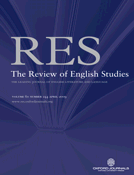-
Views
-
Cite
Cite
John M. Ganim, william f. woods. Chaucerian Spaces: Spatial Poetics in Chaucer's Opening Tales., The Review of English Studies, Volume 60, Issue 244, April 2009, Pages 297–299, https://doi.org/10.1093/res/hgn150
Close - Share Icon Share
Extract
Chaucerian Spaces book joins such arresting studies as David Wallace's Premodern Places and Kathy Lavezzo's Angels at the End of the World in demonstrating the degree to which place and space are themselves significant forms in late medieval literature, amenable to analysis and interpretation to the same extent as language, form, and style. This new emphasis follows a major change in critical theory over the past few decades. In The Postmodern Condition, published over 30 years ago, Jean-François Lyotard noted that postmodern culture replaces the categories of time, history, and progressive change with categories of space, place, borders, and margins. Why should time be valorised as dynamic, transformative, and significant, and space be dismissed as inert, passive, and blank, asked Henri Lefebvre, who often invoked medieval examples? The model of thinkers such as Michel de Certeau and Pierre Bourdieu demonstrated how such an analysis could be executed, replacing the largely psychological interpretation of space offered by earlier thinkers such as Gaston Bachelard with a social dimension. Although some medievalists such as Paul Strohm pointed us in these directions early on, fully developed studies testing such approaches are only just now beginning to appear, of which Woods's book is among the first. Despite the complexity of some of these informing ideas, Woods's is admirably, even enviably, lucidly written.



